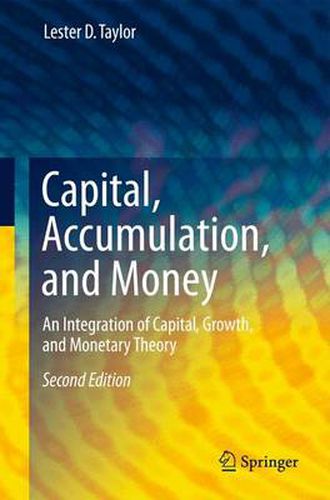Readings Newsletter
Become a Readings Member to make your shopping experience even easier.
Sign in or sign up for free!
You’re not far away from qualifying for FREE standard shipping within Australia
You’ve qualified for FREE standard shipping within Australia
The cart is loading…






This title is printed to order. This book may have been self-published. If so, we cannot guarantee the quality of the content. In the main most books will have gone through the editing process however some may not. We therefore suggest that you be aware of this before ordering this book. If in doubt check either the author or publisher’s details as we are unable to accept any returns unless they are faulty. Please contact us if you have any questions.
Capital, Accumulation, and Money: An Integration of Capital, Growth, and Monetary Theory is a book about capital and money. A root concept of capital is formulated that allows for most existing concepts of capital to be unified and related to one another in consistent fashion. Capital and monetary theory are integrated in a non-mathematical framework that imposes a number of constraints on the macro behavior of an economy, constraints which make for the straightforward understanding of such concepts as the real stock of money, real-balance effects, and the general price level. New and illuminating insights are also provided into aggregate supply and demand, natural and money rates of interest, the relationship between real and monetary economies, and economic growth and development. This fully expanded, revised, and updated edition features important new material on a variety of timely topics, including: * Factors leading to the financial meltdown and turmoil of 2007-09; * Why bubbles form in asset markets and how these impact on the real economy; * The importance of a lender-of-last-resort in times of financial stress; * Future financing and funding of the U. S. Social Security System. Additionally, the author offers a number of ideas for alleviating the severity, if not the avoidance altogether, of financial crises in the future. This is a book for those – students (both graduate and undergraduate) and their teachers, investors, and the informed public – who want an understanding of how economies and financial markets function, without an advanced degree in mathematics.
$9.00 standard shipping within Australia
FREE standard shipping within Australia for orders over $100.00
Express & International shipping calculated at checkout
This title is printed to order. This book may have been self-published. If so, we cannot guarantee the quality of the content. In the main most books will have gone through the editing process however some may not. We therefore suggest that you be aware of this before ordering this book. If in doubt check either the author or publisher’s details as we are unable to accept any returns unless they are faulty. Please contact us if you have any questions.
Capital, Accumulation, and Money: An Integration of Capital, Growth, and Monetary Theory is a book about capital and money. A root concept of capital is formulated that allows for most existing concepts of capital to be unified and related to one another in consistent fashion. Capital and monetary theory are integrated in a non-mathematical framework that imposes a number of constraints on the macro behavior of an economy, constraints which make for the straightforward understanding of such concepts as the real stock of money, real-balance effects, and the general price level. New and illuminating insights are also provided into aggregate supply and demand, natural and money rates of interest, the relationship between real and monetary economies, and economic growth and development. This fully expanded, revised, and updated edition features important new material on a variety of timely topics, including: * Factors leading to the financial meltdown and turmoil of 2007-09; * Why bubbles form in asset markets and how these impact on the real economy; * The importance of a lender-of-last-resort in times of financial stress; * Future financing and funding of the U. S. Social Security System. Additionally, the author offers a number of ideas for alleviating the severity, if not the avoidance altogether, of financial crises in the future. This is a book for those – students (both graduate and undergraduate) and their teachers, investors, and the informed public – who want an understanding of how economies and financial markets function, without an advanced degree in mathematics.